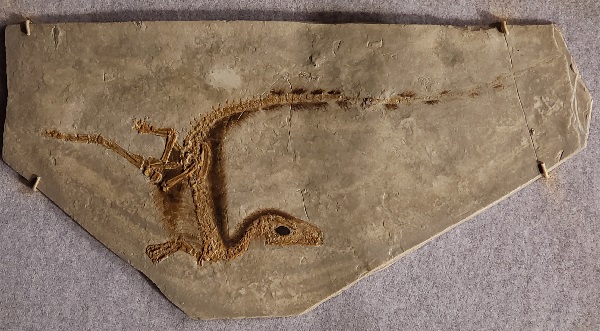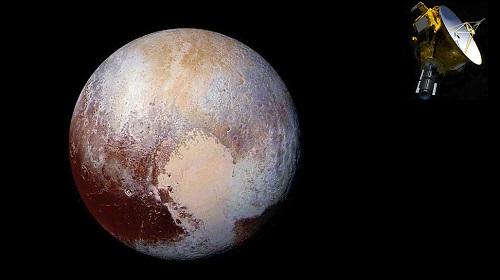I had the opportunity to visit the Grand Canyon this summer. It was a vacation I was looking forward to, but not just to see the beautiful vistas like the one above. Knowing the canyon reveals truths difficult to see anywhere else, I was looking forward to seeing truth about the earth that you’re unlikely to see elsewhere. Well, the canyon didn’t disappoint. I had expected to see evidence of the global flood, and that is definitely there. What I didn’t expect to see is evidence of creation as God described in Genesis. That’s also there. As the heavens declare the glory of God (Ps 19.1), the Grand Canyon declares his creation and Noah’s flood, written in stone for those who are paying attention. Let me explain.
Continue Reading
Category Archives: Global Flood
A Dinosaur by any other name …

The title is of course a play on the line from Shakespeare’s play Romeo and Juliet, where Juliet laments the fact that her new found love Romeo is from the family of Montague. The two families, the Montagues and Juliet’s family, the Capulets, have been feuding for some time, which sometimes erupted into dueling. The animosity between the two families sets the background for the play. Juliet expresses her dismay with the famous discourse that begins with “O Romeo, Romeo, wherefore art thou Romeo?” and includes the lines:
‘Tis but thy name that is my enemy;
Thou art thyself, though not a Montague.
What’s Montague? It is nor hand, nor foot,
Nor arm, nor face, nor any other part
Belonging to a man. O, be some other name!
What’s in a name? That which we call a rose
By any other name would smell as sweet;
Juliet’s well put and clear meaning being that Romeo would still be Romeo if he were called by any other name. Which is where we pick it up concerning dinosaurs.
Dinosaurs by Any Other Name are Still Dinosaurs
I originally wanted to call this article “Dragons are Dinosaurs.” But dinosaurs are also called by other names and perhaps just as importantly the term “Dinosaur” is limited to land-dwelling creatures, but I want to cover flying and swimming creatures as well. Continue Reading
The Self-Refuting Dino to Bird Theory

Sinosauropteryx fossil Note dark region on along the back – claimed by evolutionists to be feathers.
Don’t laugh, but dyed-in-the-wool evolutionists believe that therapod dinosaurs like T-Rex evolved into birds. In fact they don’t stop there. They also believe that dinosaurs didn’t really go extinct. They’ll tell you when you’re looking at birds, you’re looking at dinosaurs. “We don’t have to talk about how dinosaurs went extinct anymore because they’re all around us. Once you realize that, you can never look at a bird the same way again”[1] says ornithologist and evolutionary biologist Rick Prum. A recent article on the topic of dino to bird evolution states in the subtitle “Birds aren’t descended from dinosaurs, They are dinosaurs.”[2] So yes, they really believe dinosaurs evolved into birds. Continue Reading
The Gilgamesh Epic – A problem for the flood?

Correct proportions of the vessel in the “Gilgamesh Epic – a cube, not a ship
The Gilgamesh Epic is a series of Sumerian poems that tell heroic stories about the Sumerian god Gilgamesh. Included in the poems is a story of a global flood. That story is named after the people in Mesopotamia who occupied the land after the Sumerians – the Babylonians. The stories are written in clay tablets in cuneiform – one of the oldest, if not the oldest, form of writing known. Thus the Epic of Gilgamesh has come to be known as the Babylonian flood epic, and is one of the oldest written stories known.
Secularists who (true to form) deny the existence of the supernatural of course do not believe the Babylonian flood epic either. But they use it as a means to try to disprove the Biblical flood epic since that is clearly a symbol of divine judgment. Using the story of Pandora as an example, their logic goes something like this:
The story of Pandora and the closed box of evil that she opens which releases all manner of evil upon the world is myth, not to be believed.
The story of Eve in the garden of Eden who takes a bite of the forbidden fruit, which releases all manner of sin and evil upon the world is borrowed from the story of Pandora, and thus is also a myth, not to be believed.
The Global Flood: The Best Evidence for Creation?

The Bible states that the heavens and the earth were created in six literal days. God created Adam and Eve and placed them in a garden called Eden. Adam and Eve sinned, bringing sin into God’s perfect creation, and sin brought with it the consequence of death. The Bible goes on to state that:
“The LORD saw how great man’s wickedness on the earth had become, and that every inclination of the thoughts of his heart was only evil all the time.” (Gen 6.5)
So God elected to start over, wiping all the wicked people off the face of the earth and begin again with the family of one righteous man: Noah (Gen 6:8-10).
What is the best evidence of this creation account? The first question to answer is what kind of evidence should we be looking for? The first criteria is that it should be evidence that is accessible and acknowledged by all – on both sides of the debate. The second criteria has to do with the explanatory power of the evidence, which is explained below. Continue Reading
Do Ancient Chronologies Challenge the Bible? Part 3: The Tower of Babel

The construction of the Tower of Babel
In parts 1 and 2, we saw how misunderstandings of ancient texts led to commonly held, but incorrect views. Part one demonstrated why the early date of the exodus – 1446 BC – is the correct date. Part two demonstrated that commonly held Egyptian chronology is off and identified the amount of the error at the point of the exodus by identifying the pharaoh of the Exodus. (Hint: it’s not Rameses or any of the other commonly suggested pharaohs.) Here in part three we see a more egregious error: An outright denial of Biblical truth. Whereas in parts one and two those who came to the wrong conclusions likely did so honestly – by simply misunderstanding the text. But there can be no mistake here: it is clear the error here can only be arrived at by an outright denial of the biblical text – and its related teachings – at many levels. Let me give you an illustration of why this must be the case. Continue Reading
Do Ancient Chronologies Challenge the Bible? Part 2: Egyptian Chronology & the Pharaoh of the Exodus

Pyramids at Giza
In part one, on the way to determining how far off standard Egyptian Chronology is, I pointed out 3 ways scientists and non-believers use time or Chronology to cast doubts on biblical time frames:
1. Scientist think the Biblical account is too young (e.g. age of the earth/universe) 2. Scientist can’t find evidence of the event in the time period they think it happened (e.g. The Exodus) or 3. Scientists believe they have found evidence that disproves the Biblical time line (e.g. Biblical artifacts like the Dendera Zodiak (below) or the Egyptian pyramids (above). Continue Reading
Do Ancient Chronologies Challenge the Bible? Part 1: The Date of the Exodus

Moses parting the Red Sea so the children of Israel could cross during the Exodus
Editor’s note: This article began as a demonstration of errors in Egyptian chronology, but to get there it was necessary to first lay down foundational information concerning the exodus. Which pushed back the Egyptian info to part 2. What follows is the foundational info on the exodus.
A common way to try to discount Biblical truth is to to challenge the event based upon the age. The challenge comes either because 1. Scientist think the Biblical account is too young (e.g. age of the earth/universe) 2. Scientist can’t find evidence of the event at the time period they think it happened (e.g. The Exodus) or 3. Scientists believe they have found evidence that disproves the Biblical time line (e.g. ancient artifacts like the Dendera Zodiak or the below Egyptian pyramids.)
This is ironic because out of all the things science can do, one thing it cannot do is measure age directly. Age – the amount of time passed – is not something you can measure with instruments after the fact. Yet it is one thing scientists tend to get the most adamant about. But when scientists claim to be measuring the age, what they’re really doing is measuring a property of something that usually varies regularly with time, such as the number of half lives of a radioactive element, or the number or rings in a tree trunk. But strictly speaking, they are not measuring age. And more importantly – the assumptions they make when attempting to determine the age are often wrong, throwing the estimated age off.[1]
Are You Ashamed to Be A Creationist?

Are you ashamed to be called a “creationist”? If you’re taking cues from certain Intelligent Design (ID) proponents, you might feel like the label “creationist” is a label to avoid at all costs. Here’s why that’s both the wrong approach and dishonoring to God. Continue Reading
Lessons from Pluto
On January 19, 2006 the “fastest spacecraft ever launched”[1] – the New Horizons space probe – lifted off from Cape Canaveral, Florida on a mission to Pluto. In February of 2007 it collected data from Jupiter as it flew by for a gravity assist catapult as it continued on to Pluto. On July 14th, 2015, New Horizons made its closest approach to Pluto. Scientists have now had an opportunity to review the initial data and pictures from New Horizons about the dwarf planet[2] Pluto, and many have been forced into a stunning but unavoidable admission: they’ve been wrong about Pluto for a long time.
What they found on Pluto was not at all what they were expecting to find. Scientists were expecting to find it heavily cratered, “a flat, dead world similar to our moon.”[3] Instead, what they actually found was:
- Icy Volcanoes
- The heart shaped area (right side partially faded) visible in the picture above named sputnik planum, of which scientists note “…this Texas sized basin of ice appears to be boiling.” [4] Planetary scientist Jani Radebaugh likens it to “a lava lake in slow motion”[5] made of nearly frozen Nitrogen cooled until the texture is that of tooth paste.
- Other areas feature a young looking surface, with no record of crater bombardment as expected. “These features are very, very young…Pluto is active today. That’s the headline.”[6] says Planetary scientist Dan Durda.
- An active geology driven by heat
- and “there’s pretty good circumstantial evidence that Pluto has a massive ocean in its interior”[7] says New Horizons mission principle investigator Alan Stern.
Secular Blindness
While scientists are willing to fess up to being wrong when confronted with objective data like that supplied to them from their own instruments aboard the New Horizons space probe, it is unlikely that they are willing to acknowledge error with regard to the below lessons, save the first, which they cannot deny without being accused of being science deniers. Continue Reading


